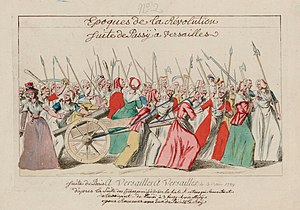| Women's March on Versailles | |||
|---|---|---|---|
| Part of the French Revolution | |||
 A contemporary illustration of the Women's March on Versailles, 5 October 1789 | |||
| Date | 5 October 1789 | ||
| Location | |||
| Parties | |||
| Units involved | |||
| |||
The Women's March on Versailles, also known as the October March, the October Days or simply the March on Versailles, was one of the earliest and most significant events of the French Revolution. The march began among women in the marketplaces of Paris who, on the morning of 5 October 1789, were nearly rioting over the high price of bread. The unrest quickly became intertwined with the activities of revolutionaries seeking liberal political reforms and a constitutional monarchy for France. The market women and their allies ultimately grew into a crowd of thousands. Encouraged by revolutionary agitators, they ransacked the city armory for weapons and marched on the Palace of Versailles. The crowd besieged the palace and, in a dramatic and violent confrontation, they successfully pressed their demands upon King Louis XVI. The next day, the crowd forced the king and his family to return with them to Paris. Over the next few weeks most of the French assembly also relocated to the capital.
These events ended the king's independence and heralded a new balance of power that would ultimately displace the established, privileged orders of the French nobility in favor of the common people, collectively known as the Third Estate. By bringing together people representing the sources of the Revolution in their largest numbers yet, the march on Versailles proved to be a defining moment of the Revolution.